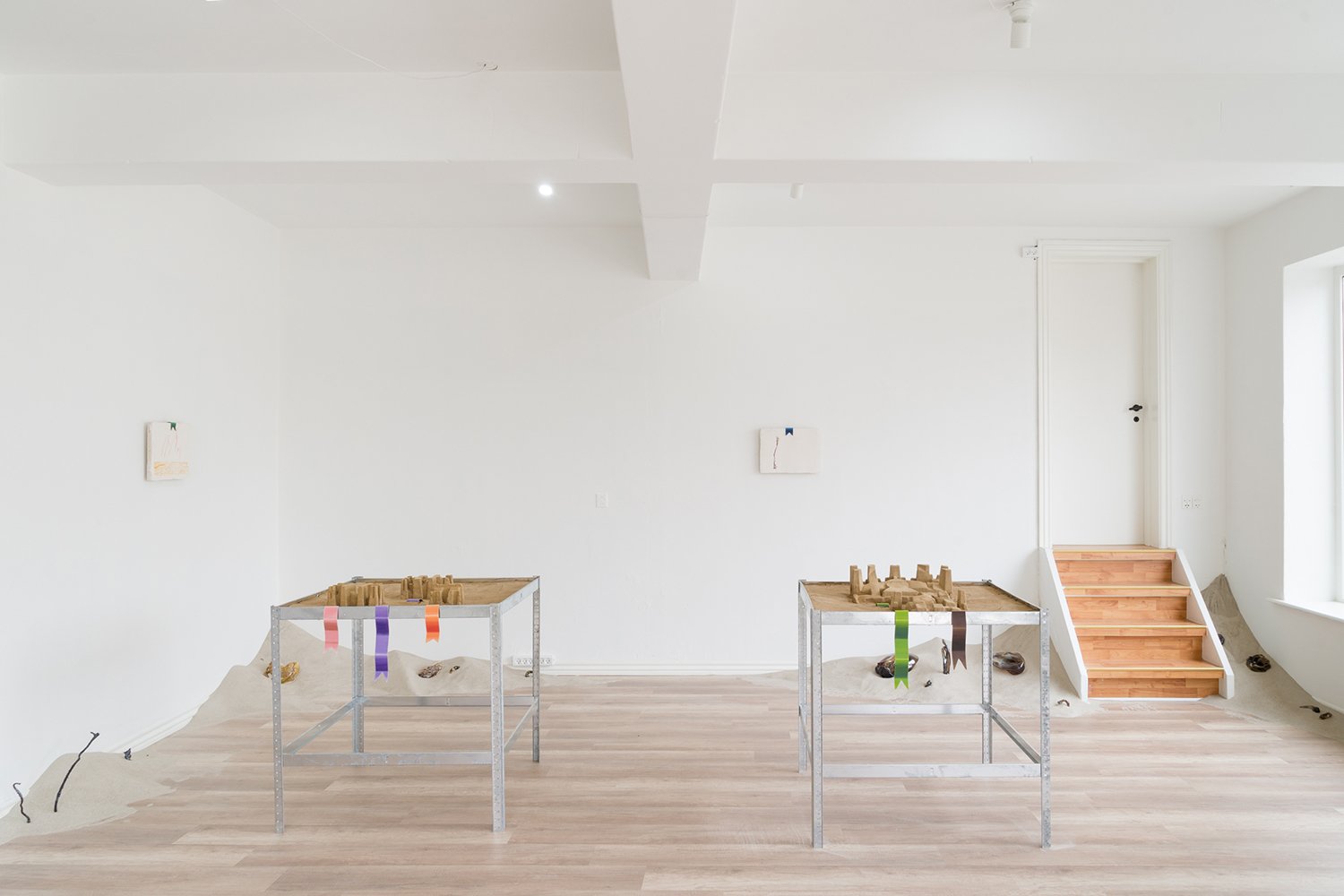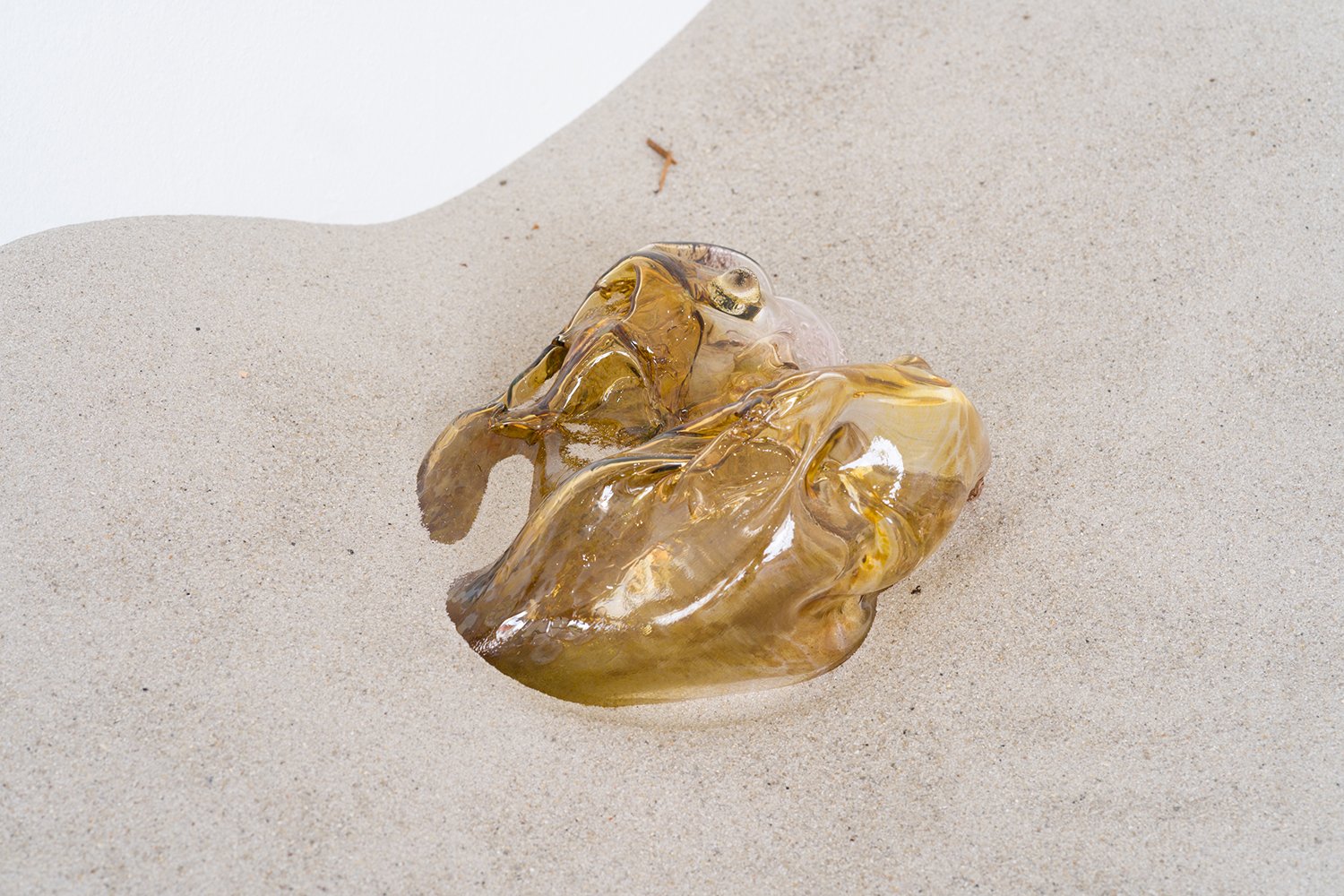Luna Lund Jensen og Kasper Holm Jensen, Post Oceanic Wonders. SKAL Contemporary. Foto: Luna Lund Jensen.
Pressemeddelelse, juli 2022
Der noget på spil mellem livet og naturen på Skagens Odde. Områdets forhistorie vidner om barske og nærmest umenneskelige tilstande på grund af tidligere tiders klimaforandringer, og Post Oceanic Wonders tager med udgangspunkt i forhistorien fat i mulige scenarier for fremtiden her.
Fredag d. 22. juli åbner SKAL Contemporary dørene for udstillingen Post Oceanic Wonders, der viser værker af kunstnerne Luna Lund Jensen og Kasper Holm Jensen. Udstillingen skuer tilbage på områdets dramatiske historie, først som havbund, senere som odde, der generation efter generation har vokset sig større og større, og siden som offer for sandflugten og vindens tiltagende kræfter på Danmarks nordligste egn. Vi betragter i dag indlandsklitterne gennem nostalgiske briller, fordi kunstens blik de seneste to århundrede har dvælet ved dette særlige landskab. Samtidig er historien om, hvordan naturkræfterne har taget magten over et område ikke særlig eller enestående i et globalt perspektiv. Vi ser tendenser ude i verden i dag, hvor vejrforhold, vind og hav med ubarmhjertig kraft og vold raserer store områder og ødelægger samfund, som det også skete på Skagens Odde under sandflugten.
Kasper Holm Jensen, Wonder of Dusty Necropolis III (marked rose, violet and orange). Foto: Luna Lund Jensen.
Kasper Holm Jensen, Wonders of Dusty Necropolis II (marked grassgreen and brown). Foto: Luna Lund Jensen.
Kasper Holm Jensen, Mene Tekel Upharsin (marked blue). Foto: Luna Lund Jensen.
Kasper Holm Jensen, Wonders of Dusty Necropolis II (marked grassgreen and brown). Foto: Luna Lund Jensen.
Kasper Holm Jensen, the Colour of The Sun cut Flat (marked green).
Foto: Luna Lund Jensen.
Luna Lund Jensen, Statisk skildring af meteorologisk gennemstrømning. Foto: Luna Lund Jensen.
Luna Lund Jensen, Statisk skildring af meteorologisk gennemstrømning. Foto: Luna Lund Jensen.
Luna Lund Jensen, Statisk skildring af meteorologisk gennemstrømning. Foto: Luna Lund Jensen.
Luna Lund Jensen, Statisk skildring af meteorologisk gennemstrømning. Foto: Luna Lund Jensen.
Luna Lund Jensen, Statisk skildring af meteorologisk gennemstrømning. Foto: Luna Lund Jensen.
Luna Lund Jensen, Statisk skildring af meteorologisk gennemstrømning. Foto: Luna Lund Jensen.
Luna Lund Jensen, Statisk skildring af meteorologisk gennemstrømning. Foto: Luna Lund Jensen.
Post Oceanic Wonders dvæler ved fortidshistorierne med inspiration fra landskabet og kunsten og fremmaner scenarier for fremtiden, som er præget af planetens naturlige forgængelighed og ængstelige fortællinger om, hvad klimaforandringer og ubalance i biodiversiteten på grund af (over)forbrug af naturens ressourcer kan medføre. Om udstillingens tema fortæller kurator Sara Løvschall Grøntved:
“Det er vigtigt for os med SKAL at sætte noget på spil, og det gør vi ved at dykke ind i konkrete omstændigheder, udfordringer, fænomener og så videre, som på en eller anden måde har haft betydning for livet på et sted. Altså, menneskets relation til det, der er omkring os. Post Oceanic Wonders går ind i de dramatiske sider af Skagens Oddes forhistorie, men bruger samtidig denne historie og kunsten til at sætte fokus på mere aktuelle udfordringer som bl.a. klimaforandringer, naturkræfter og jordens ressourcer.”
Post Oceanic Wonders fokuserer på Skagens Oddes forhistorie som havbund og de forhold, som dette har skabt for det kun 10.000 år gamle landområde. Landskaberne og livet i Skagen har været dramatisk og storslået, men det er også koblet til en nostalgi som er romantiseret i en grad, så det kan være svært at bevæge sig omkring på hovedgaden i Skagen i juli for bare stråhatte.
Luna Lund Jensen og Kasper Holm Jensen, Post Oceanic Wonders. SKAL Contemporary. Foto: Luna Lund Jensen.
Luna Lund Jensen, Statisk skildring af meteorologisk gennemstrømning.
Foto: Luna Lund Jensen.
Luna Lund Jensen, Statisk skildring af meteorologisk gennemstrømning. Foto: Luna Lund Jensen.
Luna Lund Jensen, Statisk skildring af meteorologisk gennemstrømning. Foto: Luna Lund Jensen.
Kasper Holm Jensen, Wonders of Dusty Necropolis I (marked teal).
Foto: Luna Lund Jensen.
Kasper Holm Jensen, Wonders of Dusty Necropolis I (marked teal).
Foto: Luna Lund Jensen.
Post Oceanic Wonders skaber fremtidsforestillinger i video, lyd, ler, kalk og glas med udgangspunkt i et billede af vores omgivelser, som ikke kun er præget af fortiden, men den måde som vi forbruger vores omgivelser; som råvare, som repræsentant for historie og nostalgi og som rå kraft, der ubarmhjertigt ødelægger og æder både landskaber og samfund.
Fernisering: Fredag d. 22. juli, kl. 15.30-18.
Udstillingsperiode: 22. juli - 18. september, 2022.
Åbningstider: Til 1. september: Ons-søn: kl. 12-16. Til 18. september: Fre-søn: kl. 12-16.
Mere info: www.skalcontemporary.dk
Post Oceanic Wonders er venligst støttet af Statens Kunstfond, Region Nordjylland, Frederikshavns Kommune, Ny Carlsbergfondet, KulturKANten, 15. Juni Fonden, Knud Højgaards Fond og Beckett Fonden.
Luna Lund Jensen og Kasper Holm Jensen, Post Oceanic Wonders. SKAL Contemporary. Foto: Luna Lund Jensen.
Luna Lund Jensen, Dynamisk skildring af meteorologisk ophobning.
Foto: Luna Lund Jensen.
Kasper Holm Jensen, We have Drunken of Things Lethean (marked red). Foto: Luna Lund Jensen.
Luna Lund Jensen, Statisk skildring af meteorologisk gennemstrømning. Foto: Luna Lund Jensen.
Luna Lund Jensen, Statisk skildring af meteorologisk gennemstrømning. Foto: Luna Lund Jensen.
Luna Lund Jensen, Statisk skildring af meteorologisk gennemstrømning. Foto: Luna Lund Jensen.
Luna Lund Jensen og Kasper Holm Jensen, Post Oceanic Wonders. SKAL Contemporary. Foto: Luna Lund Jensen.
Luna Lund Jensen, Statisk skildring af meteorologisk gennemstrømning. Foto: Luna Lund Jensen.
Luna Lund Jensen, Statisk skildring af meteorologisk gennemstrømning. Foto: Luna Lund Jensen.
Exhibition text
Our perception of the surrounding landscapes that we have watched for hours and hours over the course of a lifetime through windows, paintings, and images is shaped and perhaps even defined by the narratives that these images have collectively created. Art and the increasing circulation of images during the 19th and 20th centuries have shaped narratives which, through innumerable representations of cornfields and horizon lines, have romanticised these landscapes and nurtured a national romantic feeling, which has since been used to promote agriculture and tourism, among other things.
Post Oceanic Wonders is a newly produced exhibition by Luna Lund Jensen and Kasper Holm Jensen, which looks back at the landscapes of the past, and how the landscapes we know have been immortalised for both admiration and for the sake of warning for posterity. A landscape is a delimited geological area that stands out, as well as a place that are created culturally – that is, places where humans have intervened with the natural conditions. Nature is an abstract conceptual capacity – what can in fact be claimed as originally nature? As beautifully conveyed in Amalie Smith's video work Hus, hav (House, Sea), the landscape is constantly moving; one landscape is constantly taken over by a new one, so it becomes interesting to explore what lies behind this decision when we decide to maintain a landscape as something worthy of preservation or a definite cultural heritage. The changeability of landscapes is governed by the forces of nature regardless of human needs and demands. Skagen's Odde was seabed during the last ice age, and as the ice melted, the land rose out of the sea, and the landscape must be said to have undergone extreme changes in the last 12,000 years.
Post Oceanic Wonders thematizes the volatility of landscapes, which governs the human need for restraint and retention, linked to the romanticization of landscapes we know from the art and political discourses of national romanticism. These discourses represent a retention of the understanding of what Denmark is, and what “the real” Denmark looks like. There was a resolution to stop the constant battle with sand migration on Skagens Odde; the solution was planting special types of grass and pine trees on the dunes to retain the sand, and the landscape of the inland dunes"has now become defining for the area. This landscape has later become part of the Danish Nature Agency's nature conservation project Natura 2000, although this landscape historically is new and looks like it did after the planting of the dunes in the late 1800s. Råbjerg Mile, which is a raw natural force and a reminder of the sand migration of the past, is a protected nature area on Skagens Odde that slowly eats the landscape from the west coast to east coast. Råbjerg Mile is thus a direct image of the volatility and constant change of the landscape, but also an attribution to the fact that a decision has been made to let this big pile of sand wander through the landscape as an omnivorous external mechanism.
Post Oceanic Wonders is at once a snapshot of shapes and forms of nature and a realisation that no matter how much we struggle, nature's relentless being is omnipotent. Lund Jensen shows the works Dynamisk skildring af meteorologisk ophobning and Statisk skildring af meteorologisk gennemstrømning, which in video, sound, and glass work with the volatility of landscapes and the fragility it creates for life when battling the erratic forces of nature. Holm Jensen shows the works Wonders of Dusty Necropolis I (market teal), Wonders of Dusty Necropolis II (market grass green and brown), and Wonder of Dusty Necropolis III (market rose, violet and orange), which consist of three dioramas in clay mortar, clay, straw, galvanised steel, blind rivets, etched and painted aluminium, and the works The Color of The Sun cut Flat (market green), We have Drunken of Things Lethean (market red) and Mene Tekel Upharsin (market blue), which are three frescoes in slaked lime, sand, marble dust, pigment, reeds, wood and etched and painted aluminium inspired by Leonardo Da Vinci's storm surge drawings.
The exhibition is a dramatic and nostalgic representation of natural forces in human experience, and the narratives that have helped define our relationship to our surroundings for posterity. At the same time, new narratives and notions are shaping our impending future. Climate change, natural forces, decay. Who knows what we can expect? In this publication, we dive into the narratives that have defined our perception of the role of man in relation to nature, which are embedded in our landscapes and the way in which nature and the forces of nature are represented in art, fiction, and history.
We hope you enjoy reading along!
Many thanks goes to the Danish Arts Foundation, 15. Juni Fonden, Region Nordjylland, the municipality of Frederikshavn, Ny Carlsbergfondet, Knud Højgaards Fond, Beckett Fonden, and KulturKANten, who have supported the exhibition and the platform. A special thank you must also go to Luna Lund Jensen and Kasper Holm Jensen for their uncompromising work with the exhibition's nostalgic ladle for the past and the dubious portrayal of the future, to which the title Post Oceanic Wonders refers.




























